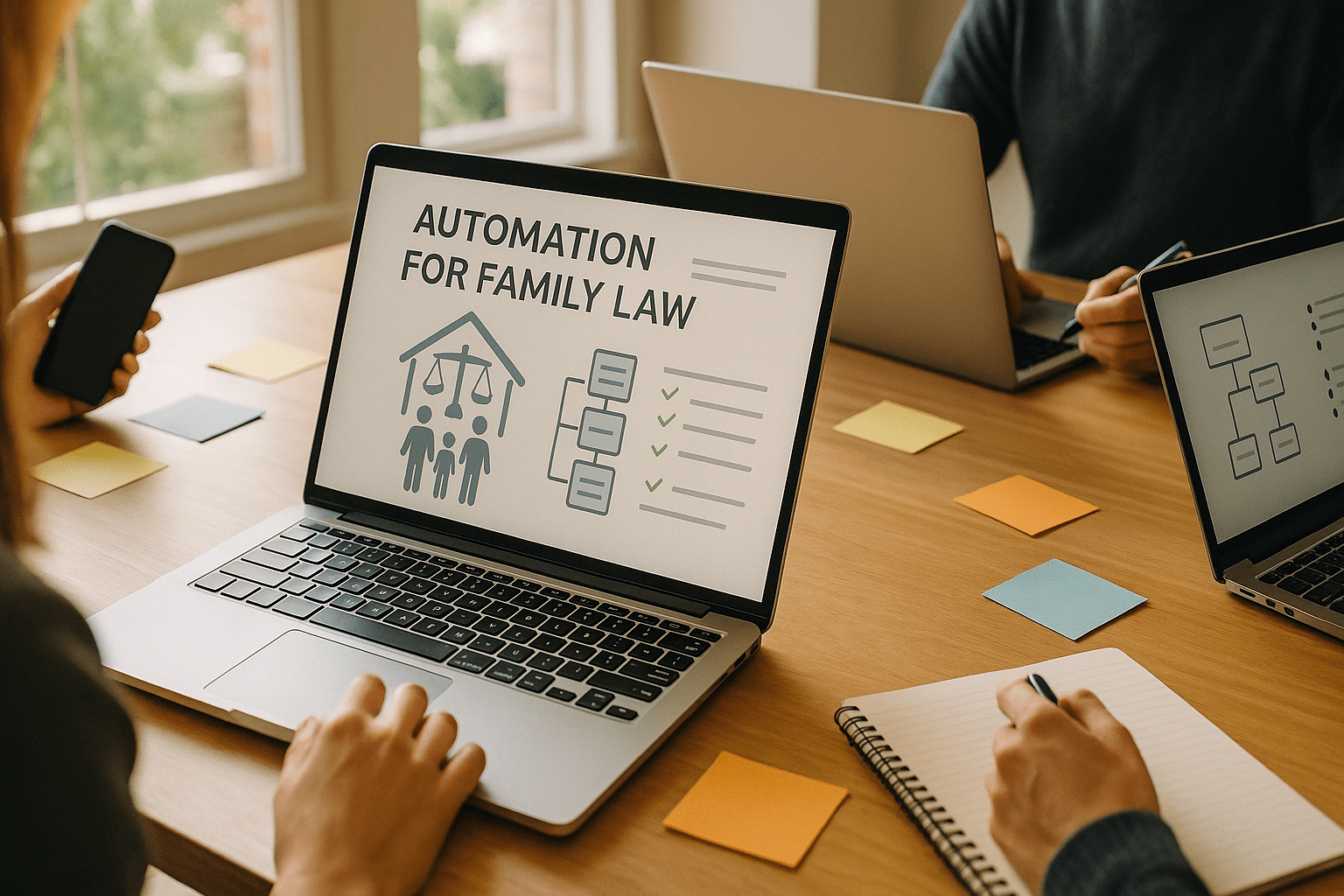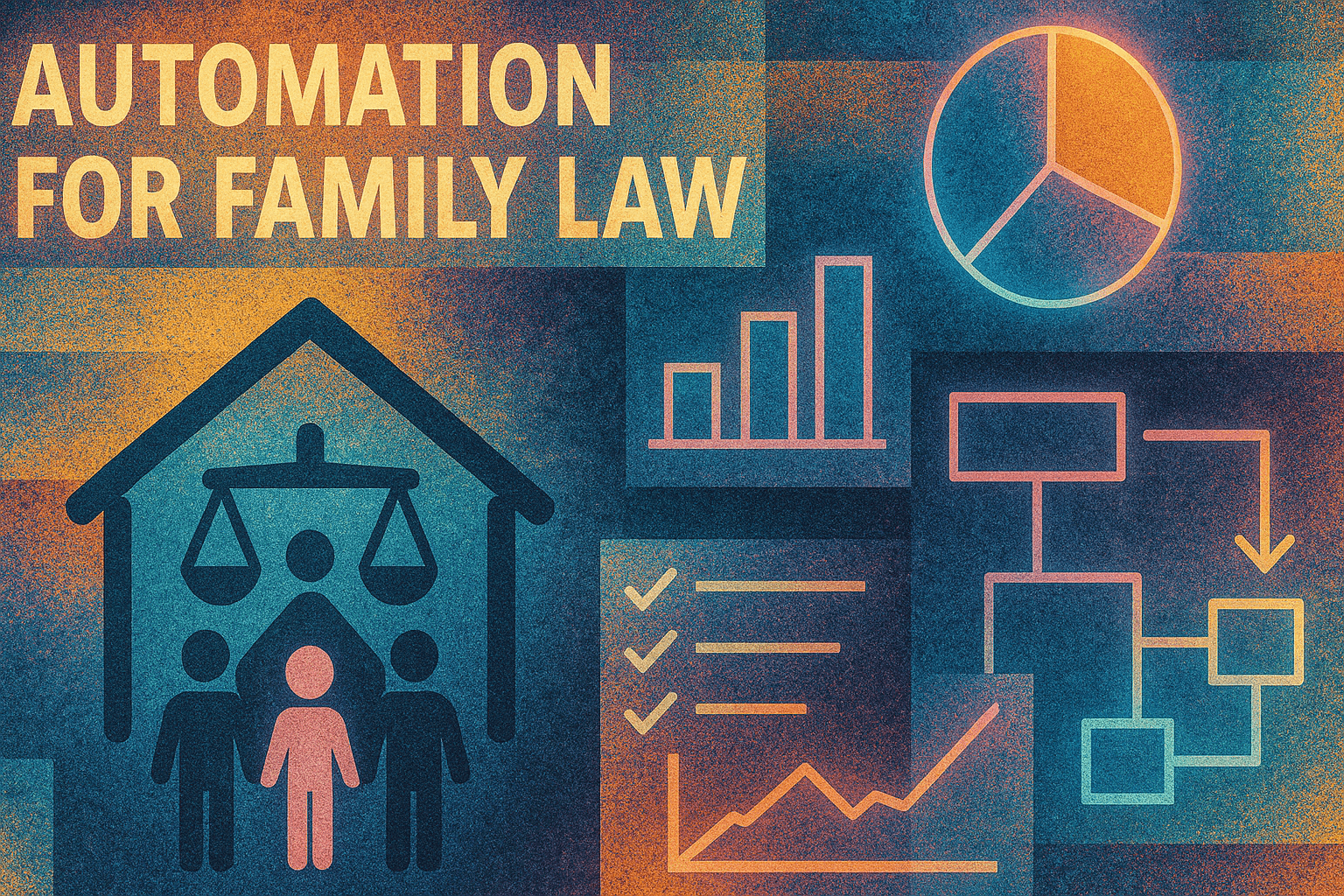Family Law Automation: Complete Guide to Streamlining Your Practice in 2026
by Design Delulu Editorial · October 10, 2025

Smart, fast, and measurable. Here's how Automation helps Family Law win.
Family law practices face a unique challenge: balancing deeply personal client relationships with increasingly complex administrative demands. Every divorce proceeding, custody arrangement, and mediation requires meticulous documentation, timely communication, and careful deadline management. Yet most family law attorneys still rely on manual processes that consume 40-60% of their billable hours on non-legal tasks like scheduling, document preparation, client intake, and follow-up communications.
Automation for family law isn't about replacing the human touch that makes your practice successful. It's about eliminating repetitive tasks so you can focus on what matters most: providing compassionate counsel during your clients' most difficult life transitions. The firms that embrace strategic automation in 2026 will gain a decisive competitive advantage through faster case processing, improved client satisfaction, higher profit margins, and the ability to scale without proportionally increasing overhead costs.

Why Family Law Practices Need Automation Now
The landscape of family law has fundamentally changed. Clients expect immediate responses, transparent pricing, and digital-first experiences. Meanwhile, administrative burden has increased with more complex reporting requirements, compliance standards, and multi-channel communication demands. Traditional practice management approaches simply cannot keep pace.
The cost of manual processes is substantial: Family law attorneys spend an average of 2.5 hours daily on administrative tasks that could be automated. At an average billing rate of $300/hour, that represents $750 in lost revenue potential per attorney, per day. Over a year, a three-attorney practice loses nearly $550,000 in opportunity cost to manual administrative work.
Client expectations have evolved: Today's family law clients research extensively before engaging counsel. They expect instant appointment booking, automated case updates, secure document sharing, and proactive communication. Practices that rely on phone tag and paper forms lose potential clients to more digitally sophisticated competitors.
Operational complexity is increasing: Managing multiple cases across different stages, tracking court deadlines, coordinating with opposing counsel, and maintaining compliance documentation creates an overwhelming operational burden. Without automation, something inevitably falls through the cracks, risking malpractice claims and client dissatisfaction.
Core Automation Opportunities for Family Law
Family law practices can automate dozens of repetitive tasks while maintaining the personal touch clients require. The key is identifying high-impact automation opportunities that deliver immediate ROI and improve both operational efficiency and client experience.
Client Intake and Onboarding
The client intake process sets the tone for the entire attorney-client relationship. Automated intake systems can capture comprehensive client information, conflict-check against existing cases, collect retainer payments, and trigger welcome sequences, all before the initial consultation.
Key automation elements:
- Smart intake forms: Dynamic questionnaires that adjust based on case type (divorce, custody, adoption) and capture all relevant information upfront
- Automated scheduling: Allow prospective clients to book consultations directly from your website based on real-time calendar availability
- Document collection: Send secure portal links for clients to upload financial documents, identification, and relevant correspondence before the first meeting
- Payment processing: Collect consultation fees and retainers automatically with integrated payment systems
- Welcome sequences: Trigger personalized email series explaining what to expect, how to prepare, and next steps
Document Generation and Management
Family law practices generate substantial documentation: petitions, motions, discovery requests, financial affidavits, parenting plans, and settlement agreements. Document automation eliminates redundant data entry and ensures consistency across all case materials.
Automation capabilities include:
- Template-based generation: Create court-ready documents by populating templates with case data from your practice management system
- Clause libraries: Maintain approved language for common provisions and automatically insert appropriate clauses based on case parameters
- Version control: Track document revisions, compare versions, and maintain audit trails for all modifications
- E-signature workflows: Route documents for client review and signature without printing, scanning, or manual follow-up
- Court filing integration: Submit documents directly to e-filing systems with automatic docketing and confirmation tracking
Communication and Client Updates
Proactive communication distinguishes exceptional family law practices from mediocre ones. Automation ensures clients receive timely updates while reducing the communication burden on attorneys and staff.
Automated communication strategies:
- Case status updates: Trigger notifications when key milestones occur (document filed, hearing scheduled, settlement offer received)
- Appointment reminders: Send automated reminders via email and SMS 48 hours and 2 hours before scheduled meetings
- Educational content delivery: Share relevant resources based on case stage (preparing for mediation, understanding custody evaluations, financial disclosure tips)
- Response time management: Auto-acknowledge client emails and set expectations for response timing based on urgency and attorney availability
- Satisfaction surveys: Automatically solicit feedback at case milestones to identify issues early and gather testimonials

Deadline and Task Management
Missing a court deadline can result in malpractice claims and adverse case outcomes. Automated deadline tracking ensures nothing falls through the cracks while reducing the mental burden of constant deadline monitoring.
Critical automation features:
- Court rules calculation: Automatically calculate filing deadlines based on jurisdiction-specific court rules and calendaring conventions
- Multi-level reminders: Set cascading reminders at 30 days, 14 days, 7 days, and 24 hours before critical deadlines
- Task dependencies: Create automated task sequences where completing one task triggers the next (e.g., filing petition triggers service deadline)
- Team coordination: Automatically assign tasks to appropriate team members based on case type and workload distribution
- Escalation protocols: Alert supervising attorneys when deadlines are approaching without task completion
Billing and Financial Management
Family law billing requires careful tracking of time, expenses, and trust account management. Automation improves accuracy, accelerates collections, and ensures compliance with ethical billing requirements.
Financial automation includes:
- Automatic time capture: Track time spent on calls, emails, and document work without manual timer entry
- Expense tracking: Integrate with expense management tools to automatically capture and categorize case-related costs
- Invoice generation: Create detailed invoices automatically at regular intervals with customizable formats and line-item detail
- Payment reminders: Send automated payment reminders for overdue invoices with escalating urgency
- Trust accounting: Automate trust deposit tracking, interest calculation, and reconciliation reporting for IOLTA compliance
Building Your Family Law Automation Strategy
Successful automation requires strategic planning and phased implementation. Rushing to automate everything simultaneously creates confusion and resistance. Instead, follow a structured approach that delivers quick wins while building toward comprehensive automation.
Phase 1: Assess and Prioritize (Weeks 1-2)
Document current workflows: Map out how work currently flows through your practice from initial client contact through case closure. Identify bottlenecks, redundant steps, and high-friction points.
Quantify time investment: Track how much time your team spends on different activities. Focus on tasks that are frequent, time-consuming, and rule-based rather than requiring professional judgment.
Prioritize automation opportunities: Use a simple 2×2 matrix plotting impact vs. implementation difficulty. Start with high-impact, low-difficulty automations like appointment scheduling and email templates.
Set measurable goals: Define specific targets like reducing intake time by 50%, decreasing missed deadlines to zero, or improving client satisfaction scores by 20%.
Phase 2: Select and Configure Tools (Weeks 3-4)
Choose your core platform: Select a practice management system designed for family law that includes native automation features. Leading options include Clio, MyCase, and PracticePanther.
Integrate complementary tools: Add specialized solutions for specific needs like HotDocs for document automation, Calendly for scheduling, or Lawmatics for client intake and marketing automation.
Configure automation rules: Set up workflows, triggers, and templates. Start simple with basic if/then logic before advancing to complex multi-step sequences.
Customize for your practice: Adapt templates and workflows to match your specific case types, communication style, and operational preferences.
Phase 3: Test and Refine (Weeks 5-6)
Pilot with limited scope: Test automation with a subset of cases or a single attorney before firm-wide rollout. Monitor closely for errors, confusion, or unintended consequences.
Gather team feedback: Regularly check in with staff using the new systems. Identify pain points, confusion, and opportunities for improvement.
Refine and iterate: Adjust workflows based on real-world usage. Add steps, remove unnecessary complexity, and fine-tune timing and messaging.
Document processes: Create clear standard operating procedures for all automated workflows so team members understand how systems work and when to intervene manually.
Phase 4: Scale and Optimize (Weeks 7-8+)
Roll out firm-wide: Expand successful pilots across all attorneys and case types. Provide training and ongoing support during the transition period.
Monitor key metrics: Track time savings, client satisfaction, error reduction, and financial impact. Share wins with the team to build momentum and adoption.
Identify next opportunities: Once initial automations are running smoothly, tackle the next priority items on your list. Continuously improve and expand automation coverage.
Stay current: Regularly review new automation capabilities in your tools and emerging technologies. Automation possibilities expand rapidly as platforms evolve.

Measuring Automation Success
Effective automation delivers measurable improvements across operational efficiency, financial performance, and client experience. Establish baseline metrics before implementing automation, then track progress monthly.
Operational Efficiency Metrics
- Time to complete intake: Measure from initial contact to signed engagement letter (target: 50% reduction)
- Document preparation time: Track average time to prepare common documents like petitions and financial affidavits (target: 60% reduction)
- Response time to client inquiries: Monitor time between client message and attorney response (target: under 24 hours)
- Administrative time percentage: Calculate non-billable administrative work as percentage of total time (target: under 20%)
- Missed deadlines: Track any missed court deadlines or filing errors (target: zero)
Financial Performance Metrics
- Billable hours per attorney: Monitor increase in productive billable time freed up by reduced administrative burden (target: 15-20% increase)
- Revenue per attorney: Track whether increased billable capacity translates to revenue growth
- Collection rates: Measure percentage of billed time actually collected (target: above 95%)
- Days sales outstanding: Monitor average time to collect payment after billing (target: under 30 days)
- Cost per case: Calculate total operational cost divided by cases handled to track efficiency gains
Client Experience Metrics
- Client satisfaction scores: Survey clients at case milestones and closure (target: above 4.5/5.0)
- Net promoter score: Measure client willingness to refer your firm to others (target: above 50)
- Response time perception: Ask clients to rate your responsiveness (target: above 90% satisfied)
- Online reviews: Monitor quantity and quality of Google and Avvo reviews (target: above 4.5 stars)
- Client referrals: Track percentage of new clients from existing client referrals (target: above 30%)
Common Automation Pitfalls to Avoid
While automation delivers substantial benefits, poor implementation can create frustration and undermine client relationships. Avoid these common mistakes:
Over-automating communication: Not every client interaction should be automated. Maintain personal touchpoints for sensitive discussions, case strategy, and relationship building. Use automation for logistics and information sharing, not for replacing attorney judgment or empathy.
Ignoring edge cases: Automated workflows typically handle 80% of scenarios well but fail on unusual cases. Always provide manual override options and train staff to recognize when human intervention is necessary.
Set-it-and-forget-it mentality: Automation requires ongoing monitoring and refinement. Review workflows quarterly, update templates as laws change, and incorporate feedback from team members and clients.
Insufficient training: Even the best automation fails if staff don't understand how to use it effectively. Invest in comprehensive training and create easy reference materials for common scenarios.
Generic, impersonal messaging: Automated communications should still sound human and personal. Use client names, case-specific details, and conversational tone. Avoid corporate jargon and legal terminology in client-facing messages.
Neglecting security and compliance: Automated systems must maintain attorney-client privilege and comply with data protection regulations. Ensure all tools meet security standards and train staff on proper handling of confidential information.
Industry-Specific Tips for Family Law
- Map search intent to buyer stages: Prospective family law clients typically search for information before seeking representation. Create automated nurture sequences that educate prospects about their options, rights, and what to expect from the legal process.
- Use social proof strategically: Family law clients seek reassurance during emotional decisions. Automate the collection and display of testimonials, case results, and attorney credentials throughout the client journey from website to client portal.
- Measure against a single source of truth: Consolidate all client data, case information, and performance metrics in your practice management system. Avoid maintaining separate spreadsheets or disconnected tools that create inconsistency and manual reconciliation work.
- Ship small, test fast, keep compounding wins: Don't wait for perfect automation. Launch basic workflows, gather feedback, refine based on results, and progressively improve. Small incremental improvements compound into transformative change over time.
- Automate empathy touchpoints: Family law clients need reassurance during stressful periods. Automate check-in messages during known high-stress phases (waiting for court dates, financial disclosure periods, custody evaluation timeframes) to demonstrate ongoing support.
- Segment communication by case type: Divorce, custody, adoption, and mediation clients have different information needs and emotional states. Create case-type-specific automation sequences that provide relevant guidance and appropriate tone.
Technology Stack for Family Law Automation
Building an effective automation system requires selecting the right combination of tools that integrate seamlessly. Here's a recommended technology stack for family law practices:
Practice Management Core: Clio, MyCase, or PracticePanther serve as your central hub for case management, time tracking, billing, and client communication. Choose one that offers robust API integrations and native automation features.
Document Automation: HotDocs or Smokeball for complex document assembly with conditional logic. These tools integrate with practice management systems to pull client data and generate court-ready documents instantly.
Client Intake: Lawmatics or Clio Grow specialize in automated client intake, lead management, and marketing automation specifically designed for law firms. They capture leads, qualify prospects, and streamline conversion to clients.
Scheduling: Calendly or Acuity Scheduling allow clients to self-book consultations and meetings based on real-time attorney availability, eliminating phone tag and reducing no-shows with automated reminders.
Communication: Your practice management system should handle most client communication, but consider Mailchimp or Constant Contact for broader marketing automation and newsletter distribution.
Payment Processing: LawPay or CPACharge specialize in legal payment processing with trust account management, ensuring compliance with IOLTA requirements and bar association regulations.
E-Signature: DocuSign, Adobe Sign, or Clio's built-in e-signature for routing documents to clients, opposing counsel, and courts for electronic signature without printing and scanning.
Integration Platform: Zapier connects different applications when native integrations don't exist, allowing you to create custom automation workflows across your entire technology stack.
ROI of Family Law Automation
Automation delivers measurable return on investment through multiple channels. Here's what a typical three-attorney family law practice can expect:
Time savings: Reducing administrative time by 50% frees up 3.75 hours per attorney per day. At $300/hour billing rate, that represents $1,125 in additional billable capacity per attorney daily, or $275,625 annually for three attorneys (assuming 245 billing days).
Cost reduction: Automation reduces the need for administrative staff or allows existing staff to handle more cases. A practice might defer hiring an additional paralegal ($60,000 salary plus benefits) or administrative assistant ($45,000) as caseload grows.
Improved collections: Automated invoicing and payment reminders typically improve collection rates by 5-10 percentage points. For a practice billing $900,000 annually, a 7% improvement adds $63,000 to collected revenue.
Client acquisition: Better client experience leads to more referrals and positive reviews. A 25% increase in client referrals (from 20% to 25% of new clients) can add 15-20 new cases annually worth $150,000-$200,000 in revenue.
Total potential impact: Conservative estimates suggest a three-attorney practice can realize $400,000-$500,000 in combined increased revenue and avoided costs within the first year of implementing comprehensive automation. Investment in tools and implementation typically ranges from $25,000-$50,000, delivering an ROI of 800-2000%.
Getting Started with Automation
Ready to transform your family law practice with automation? Here's your immediate action plan:
Week 1: Conduct a workflow audit. Document how your team currently handles intake, case management, communication, document preparation, and billing. Identify the top three most time-consuming or error-prone processes.
Week 2: Research and demo practice management systems with strong automation capabilities. Focus on platforms designed specifically for family law with proven track records and active user communities.
Week 3: Select your core platform and complementary tools. Negotiate pricing, clarify implementation timelines, and confirm integration capabilities. Ensure the vendor provides adequate training and support.
Week 4: Configure your first automation workflows. Start with appointment scheduling, client intake forms, and email templates. Keep it simple and focus on immediate wins that demonstrate value to the team.
Week 5-6: Pilot your initial automations with a subset of cases. Monitor closely, gather feedback, and refine workflows. Address concerns and resistance quickly to maintain momentum.
Week 7-8: Expand successful automations firm-wide while beginning to tackle your next priority automation opportunities. Celebrate wins and share success metrics with the team to build enthusiasm.
Ongoing: Schedule quarterly reviews of your automation strategy. Identify new opportunities, update workflows as your practice evolves, and stay current with emerging automation capabilities in your tools.
Frequently Asked Questions
Let’s level up your Family Law business
Need services that actually move the needle for Family Law? See our approach, pricing, and timelines—then book a quick call.
Additional Resources
- Schedule Consultation
Book a 30-minute strategy call to discuss your practice's automation opportunities, get custom recommendations, and learn about our implementation process.
- View Our Work
Explore automation case studies and real results from family law practices that transformed their operations with strategic automation implementation.
- Free Resources
Access free automation templates, workflow checklists, ROI calculators, and implementation guides designed specifically for family law practices.
Related Reading

Discover how automation for electricians streamlines scheduling, invoicing, lead tracking, and customer follow-ups to boost revenue and efficiency. Get started today.

Discover how automation streamlines furniture & home decor operations with GA4 tracking, attribution modeling, and data-driven dashboards. Get your 90-day implementation roadmap.
